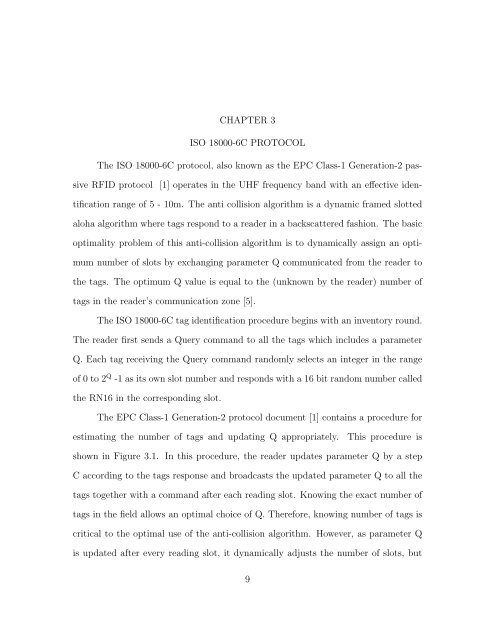utilizing physical layer information to improve rfid tag
utilizing physical layer information to improve rfid tag
utilizing physical layer information to improve rfid tag
Create successful ePaper yourself
Turn your PDF publications into a flip-book with our unique Google optimized e-Paper software.
CHAPTER 3<br />
ISO 18000-6C PROTOCOL<br />
The ISO 18000-6C pro<strong>to</strong>col, also known as the EPC Class-1 Generation-2 pas-<br />
sive RFID pro<strong>to</strong>col [1] operates in the UHF frequency band with an effective iden-<br />
tification range of 5 - 10m. The anti collision algorithm is a dynamic framed slotted<br />
aloha algorithm where <strong>tag</strong>s respond <strong>to</strong> a reader in a backscattered fashion. The basic<br />
optimality problem of this anti-collision algorithm is <strong>to</strong> dynamically assign an opti-<br />
mum number of slots by exchanging parameter Q communicated from the reader <strong>to</strong><br />
the <strong>tag</strong>s. The optimum Q value is equal <strong>to</strong> the (unknown by the reader) number of<br />
<strong>tag</strong>s in the reader’s communication zone [5].<br />
The ISO 18000-6C <strong>tag</strong> identification procedure begins with an inven<strong>to</strong>ry round.<br />
The reader first sends a Query command <strong>to</strong> all the <strong>tag</strong>s which includes a parameter<br />
Q. Each <strong>tag</strong> receiving the Query command randomly selects an integer in the range<br />
of 0 <strong>to</strong> 2 Q -1 as its own slot number and responds with a 16 bit random number called<br />
the RN16 in the corresponding slot.<br />
The EPC Class-1 Generation-2 pro<strong>to</strong>col document [1] contains a procedure for<br />
estimating the number of <strong>tag</strong>s and updating Q appropriately. This procedure is<br />
shown in Figure 3.1. In this procedure, the reader updates parameter Q by a step<br />
C according <strong>to</strong> the <strong>tag</strong>s response and broadcasts the updated parameter Q <strong>to</strong> all the<br />
<strong>tag</strong>s <strong>to</strong>gether with a command after each reading slot. Knowing the exact number of<br />
<strong>tag</strong>s in the field allows an optimal choice of Q. Therefore, knowing number of <strong>tag</strong>s is<br />
critical <strong>to</strong> the optimal use of the anti-collision algorithm. However, as parameter Q<br />
is updated after every reading slot, it dynamically adjusts the number of slots, but<br />
9
















